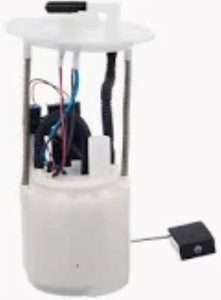However, if the fuel pump location is far from the motor/engine both serviceability and maintenance cost will be a disadvantage. In modern applications, where the fuel sits in the tank and is consumed at a leisurely pace compared to that of drag racing or track events, are provided with in-tank fuel pumps which submerge into fuel provide more than adequate lift capabilities. The only problem is, extracting these pumps usually necessitates the exhumation of the gas tank, an operation that can eat up between 3–4 hours and be upwards of $300-$600 in labor hundreds of dollars, depending on your particular make/model/configuration. This costly and time-consuming operation necessarily extends the downtime as well as overall repair bill of a car, relative to an external or in-line fuel pump.
As the name implies they are positioned in a line, typically under the vehicle at the head of they fuel rank. Since these pumps are so readily available, it is less expensive and less time-consuming to obtain and install a new part on most of them (typically 30-60 minutes labor). This can bring the cost of service down from $1000-2000 to $100-200, so quicker pumps start to make sense on high-performance or frequently modified cars. Frequently seen in racing applications, aftermarket inline fuel pumps such as those from Kemso are easily accessible and can be inspected routinely to ensure fuel delivery doesn't waver during high-demand situations.

While not known for their long life or durability, one potential benefit of using an in-tank pump is its potential to reduce the loss of vaporized fuel that often results when external pumps experience cavitation from heat. For example, cavitation can decrease the efficiency of a pump by 20 percent, particularly when operating at elevated temperatures. In-tank pumps will likely wear slower as well since they are being kept cool by the fuel, lasting beyond 100,000 miles. When they do fail however the fact that you have to drop a fuel tank on a lift because the pump is mounted there does make their serviceability more complicated and costly versus inline options.
The typical question, "what makes in-tank fuel pumps difficult to service is frequently seen. And the key is the way they are placed. The issue is that the pump is housed within (and as I discovered cannot really be removed from) the fuel tank which makes any maintenance very costly and time consuming; a scenario where one must drop the fuel tank to perform any work, thereby risking damaging other related components such as fuel lines or sensors. The situation is particularly difficult in newer models (especially with tight engine compartments) where it can prove so difficult to reach the leaking tank that additional components might need to be removed, making the repair more complex.
On the other hand, inline pumps are much more accessible for inspection and replacement, as they are usually mounted along the frame of the vehicle. This results in shorter service intervals – an important factor for performance vehicles which may necessitate pump upgrades or repairs to handle fuel flow rates of over 500 liters per alone in extreme applications.
Visit Fuel Pump, your one stop shop for reliable fuel pumps and high performance selection by Kemso to learn more about the range with easy replaceability and durability.
